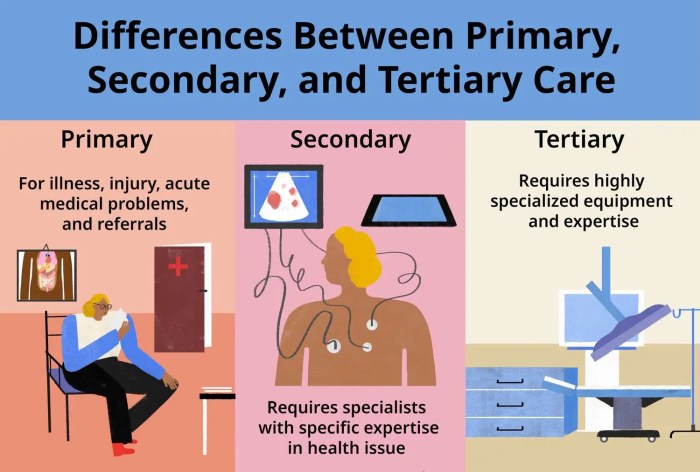Exploring the distinction between a primary care physician and an internist, this introductory paragraph sets the stage for a comprehensive comparison.
Delving into the roles, responsibilities, and patient populations of each profession, this discussion aims to shed light on the nuances between primary care physicians and internists.
Primary Care Physician vs. Internist
When it comes to healthcare, primary care physicians and internists play crucial roles in providing medical care to patients. Let's explore the key differences between these two specialties.
Role of a Primary Care Physician
A primary care physician is usually the first point of contact for patients seeking medical care. They are responsible for providing preventive care, managing common illnesses, and coordinating care for patients with complex medical conditions. Primary care physicians focus on overall health and well-being, building long-term relationships with their patients.
Responsibilities of an Internist
Internists, on the other hand, are specialists in internal medicine and focus on the diagnosis and treatment of complex medical conditions in adult patients. They are trained to manage a wide range of diseases affecting various organ systems, often providing care for patients with multiple chronic conditions.
Scope of Practice Comparison
- Primary care physicians: Provide comprehensive care for a wide range of health issues, including preventive care, routine check-ups, and basic treatment for common illnesses. They emphasize holistic health and wellness, addressing physical, mental, and emotional well-being.
- Internists: Specialize in diagnosing and treating complex medical conditions, often involving multiple organ systems. They may also provide primary care services but with a focus on managing chronic diseases and more intricate health issues.
- Collaboration: While primary care physicians serve as the initial point of contact for patients, internists may be consulted for specialized care or in cases requiring a deeper understanding of complex medical conditions.
Education and Training
To become a primary care physician or an internist, individuals must undergo rigorous educational and training requirements. Here is a breakdown of the educational paths for each profession:
Primary Care Physician
Primary care physicians typically complete the following educational requirements:
- Obtain a Bachelor's degree from an accredited institution
- Complete medical school and earn a Doctor of Medicine (MD) or Doctor of Osteopathic Medicine (DO) degree
- Pass the United States Medical Licensing Examination (USMLE) or the Comprehensive Osteopathic Medical Licensing Examination (COMLEX-USA)
- Complete a three-year residency program in family medicine, internal medicine, or pediatrics
- Obtain board certification by passing the American Board of Family Medicine (ABFM), American Board of Internal Medicine (ABIM), or American Board of Pediatrics (ABP) exams
Internist
Internists, on the other hand, pursue additional specialized training beyond medical school to become experts in adult healthcare. The educational requirements for internists include:
- Complete medical school and earn an MD or DO degree
- Pass the USMLE or COMLEX-USA
- Complete a three-year internal medicine residency program
- Internists may choose to further specialize by completing fellowships in subspecialties such as cardiology, gastroenterology, or infectious diseases
- Obtain board certification by passing the ABIM exams in internal medicine or a subspecialty
Both primary care physicians and internists may pursue additional certifications or fellowships to enhance their expertise in specific areas of medicine. These additional qualifications allow them to provide comprehensive and specialized care to their patients.
Patient Population

Primary care physicians and internists both play crucial roles in healthcare, but they often cater to different patient populations based on their training and expertise.When it comes to primary care physicians, they typically treat patients of all ages, from infants to the elderly.
They are the first point of contact for individuals seeking medical care and are responsible for managing a wide range of health issues, from routine check-ups to chronic conditions. Primary care physicians focus on preventive care, health maintenance, and overall well-being.On the other hand, internists, also known as internal medicine specialists, primarily see adult patients.
They are trained to diagnose and treat complex medical conditions in adults, often serving as consultants for other physicians. Internists may have subspecialties within internal medicine, such as cardiology or gastroenterology, allowing them to provide specialized care for specific health concerns
Primary Care Physician Patient Population
Primary care physicians typically see a diverse range of patients, including:
- Children
- Adolescents
- Adults
- Elderly individuals
Internist Patient Population
Internists usually focus on adult patients, including:
- Young adults
- Middle-aged individuals
- Elderly adults
Differences in Patient Demographics
The patient demographics between primary care physicians and internists can vary based on the age groups they primarily serve. Primary care physicians have a broader patient population that includes individuals of all ages, while internists typically specialize in adult care.
This difference in focus influences the types of conditions and health concerns that each physician encounters on a regular basis.
Medical Conditions

Primary care physicians and internists both manage a wide range of medical conditions, but there are some key differences in the types of conditions they typically treat.
Primary Care Physician
Primary care physicians are trained to manage a variety of common medical conditions. They are often the first point of contact for patients seeking medical care and are responsible for providing comprehensive and ongoing healthcare.
- Hypertension
- Diabetes
- Upper respiratory infections
- Depression and anxiety
- Arthritis
Internist
Internists, on the other hand, specialize in the diagnosis and treatment of complex medical conditions in adults. They often serve as consultants for other physicians and are experts in managing patients with multiple chronic illnesses.
- Cardiovascular diseases
- Gastrointestinal disorders
- Neurological disorders
- Pulmonary diseases
- Infectious diseases
Referral from Primary Care Physician to Internist
In cases where a patient's condition requires specialized care or further investigation, a primary care physician may refer the patient to an internist. This typically occurs when the patient's symptoms are complex, not responding to initial treatments, or when a specific expertise is needed to manage the condition effectively.
Wrap-Up
In conclusion, the differences between primary care physicians and internists are crucial in understanding the healthcare landscape. Whether it's managing common medical conditions or catering to specific patient demographics, both play distinct yet essential roles in the medical field.
Helpful Answers
What kind of patients does a primary care physician typically treat?
A primary care physician usually treats a wide range of patients, including those with general health concerns and preventive care needs.
What specialized medical conditions does an internist focus on?
Internists focus on complex medical conditions such as chronic diseases, multiple health issues, and specialized treatments.
When would a patient be referred from a primary care physician to an internist?
Patients are typically referred to an internist when they require specialized care for complex medical conditions that fall outside the scope of primary care.







